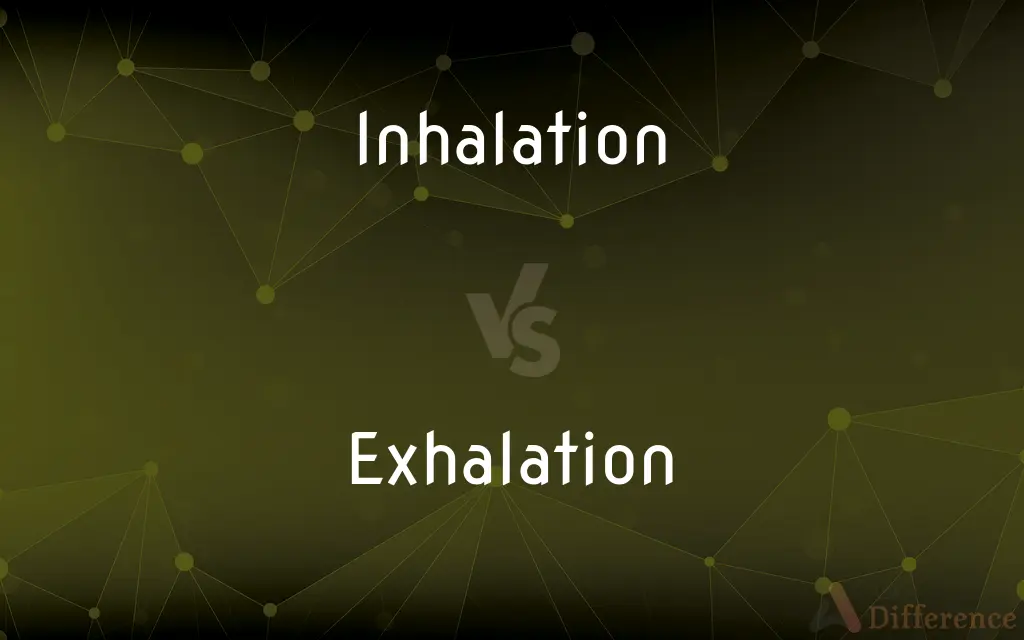Inhalation vs. Exhalation — What's the Difference?
By Maham Liaqat & Fiza Rafique — Updated on May 14, 2024
Inhalation involves drawing air into the lungs, primarily engaging the diaphragm and intercostal muscles, whereas exhalation expels air out, typically being a passive process.

Difference Between Inhalation and Exhalation
Table of Contents
ADVERTISEMENT
Key Differences
Inhalation is the process of taking air into the lungs, using muscles like the diaphragm and external intercostals to expand the chest cavity. This reduces internal pressure, allowing air to flow in. On the other hand, exhalation involves releasing air from the lungs, primarily a passive activity where the diaphragm and intercostals relax, increasing chest pressure and pushing air out.
During inhalation, the diaphragm contracts and moves downward, enlarging the thoracic cavity and decreasing the pressure inside the lung. Conversely, during exhalation, the diaphragm relaxes, moves upward, and reduces the thoracic space, forcing air out due to increased pressure.
Inhalation is an active process that can become more forceful during physical activity, requiring additional muscles such as the sternocleidomastoid and scalenes to elevate the ribcage further. Whereas exhalation under the same conditions can be active as well, involving abdominal muscles and the internal intercostals to forcibly expel air.
The control of inhalation and exhalation is managed by the respiratory center in the brainstem, which adjusts the breathing rate based on the body's carbon dioxide levels and other metabolic demands. On the other hand, factors like emotional state and speaking can voluntarily influence the pattern of exhalation, demonstrating its adaptability.
In terms of respiratory mechanics, inhalation is crucial for oxygen intake, necessary for cellular respiration and energy production. In contrast, exhalation is vital for removing carbon dioxide, a waste product of metabolism, helping to maintain acid-base balance in the body.
ADVERTISEMENT
Comparison Chart
Process Type
Active (muscle contraction)
Passive (muscle relaxation) or active
Muscles Involved
Diaphragm, external intercostals
Internal intercostals, abdominal
Direction of Diaphragm
Moves downward
Moves upward
Volume of Thoracic Cavity
Increases
Decreases
Pressure Change
Decreases
Increases
Compare with Definitions
Inhalation
The act of drawing air into the lungs.
Inhalation during exercise increases both in rate and depth.
Exhalation
The act of expelling air from the lungs.
Slow exhalation is a common relaxation technique.
Inhalation
Refers to the volume of air inhaled.
His air intake was measured during the lung function test.
Exhalation
Describes the process of pushing air out of the lungs.
Air expulsion is measured in a pulmonary function test.
Inhalation
Another term for inhalation, especially in a medical context.
The doctor measured the patient's inspiration capacity with a spirometer.
Exhalation
Refers to the expulsion of CO2 during exhalation.
Carbon dioxide release is crucial for maintaining pH balance in the blood.
Inhalation
Informal term for inhalation.
Breathing in deeply can help calm your nerves.
Exhalation
Medical term for exhalation.
Expiration becomes rapid during an asthma attack.
Inhalation
The amount of oxygen absorbed by the lungs during inhalation.
Oxygen uptake increases during vigorous activity.
Exhalation
Exhalation (or expiration) is the flow of the breath out of an organism. In animals, it is the movement of air from the lungs out of the airways, to the external environment during breathing.
Inhalation
Inhalation happens when air or other gases enter the lungs.
Exhalation
The act or an instance of exhaling.
Inhalation
The act or an instance of inhaling.
Exhalation
Something, such as air or vapor, that is exhaled.
Inhalation
An inhalant.
Exhalation
The act or process of exhaling; breathing out
Short exhalations of breath
Inhalation
The act of inhaling; inbreathing.
Exhalation
That which is exhaled, or which rises in the form of vapor, fume, or steam
Exhalations from the earth or flowers
Inhalation
The substance (medicament) which is inhaled.
Exhalation
A bright phenomenon; a meteor.
Inhalation
The act of inhaling; also, that which is inhaled.
Exhalation
The act or process of exhaling, or sending forth in the form of steam or vapor; evaporation.
Inhalation
The act of inhaling; the drawing in of air (or other gases) as in breathing
Exhalation
That which is exhaled, or which rises in the form of vapor, fume, or steam; effluvium; emanation; as, exhalations from the earth or flowers, decaying matter, etc.
Ye mists and exhalations, that now riseFrom hill or steaming lake.
Inhalation
A medication to be taken by inhaling it
Exhalation
A bright phenomenon; a meteor.
I shall fallLike a bright exhalation in the evening.
Exhalation
Exhaled breath
Exhalation
The act of expelling air from the lungs
Exhalation
Casual term for exhalation.
Breathing out slowly can help in managing anxiety.
Common Curiosities
What roles do the intercostal muscles play in breathing?
External intercostals help in inhalation by raising the ribcage, whereas internal intercostals aid in exhalation by lowering it.
Why is inhalation considered an active process?
Inhalation is active because it involves muscle contractions to expand the lung volume.
What is the primary muscle involved in inhalation?
The primary muscle involved in inhalation is the diaphragm.
Is exhalation always a passive process?
Exhalation is usually passive, but it can be active during vigorous activities or forced breathing.
What is the significance of the relaxation of the diaphragm?
Relaxation of the diaphragm during exhalation increases thoracic pressure, pushing air out of the lungs.
How do inhalation and exhalation maintain blood pH?
Inhalation absorbs oxygen necessary for metabolism, while exhalation removes CO2, maintaining pH balance.
Does the body use more muscles during forceful breathing?
Yes, additional muscles like the sternocleidomastoid are used during forceful or deep breathing.
Can exhalation be controlled voluntarily?
Yes, exhalation can be controlled and modified voluntarily, such as in speaking or singing.
How does the nervous system control breathing?
The respiratory center in the brainstem controls the rate and depth of breathing based on CO2 levels and other factors.
How do the lungs fill with air during inhalation?
During inhalation, the chest cavity expands and lowers internal lung pressure, drawing air in.
What physiological changes occur in the thoracic cavity during inhalation?
The thoracic cavity increases in volume and the diaphragm contracts downward during inhalation.
How does physical activity affect inhalation and exhalation?
Physical activity increases the depth and rate of both inhalation and exhalation to meet increased oxygen demands.
What happens to the airways during exhalation?
The airways contract slightly during exhalation, helping to expel air efficiently.
What is the effect of stress on breathing patterns?
Stress can lead to quicker, shallower breaths and disrupt the normal balance of inhalation and exhalation.
What tools are used to measure inhalation and exhalation volumes?
Spirometers are commonly used to measure both inhalation and exhalation volumes.
Share Your Discovery

Previous Comparison
Respondent vs. Defendant
Next Comparison
Metaphor vs. PersonificationAuthor Spotlight
Written by
Maham LiaqatCo-written by
Fiza RafiqueFiza Rafique is a skilled content writer at AskDifference.com, where she meticulously refines and enhances written pieces. Drawing from her vast editorial expertise, Fiza ensures clarity, accuracy, and precision in every article. Passionate about language, she continually seeks to elevate the quality of content for readers worldwide.
















































